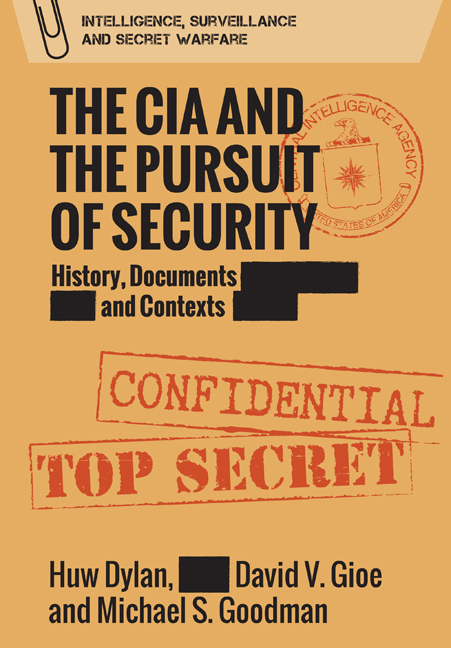Book contents
- Frontmatter
- Contents
- List of Documents
- Foreword
- Acknowledgements
- Introduction
- 1 Intelligence for an American Century: Creating the CIA
- 2 The Development of CIA Covert Action
- 3 A ‘Gangster Act’: The Berlin Tunnel
- 4 The CIA and the USSR: The Challenge of Understanding the Soviet Threat
- 5 Anglo-American Intelligence Liaison and the Outbreak of the Korean War
- 6 The CIA and the Bomber and Missile Gap
- 7 The CIA and Cuba: The Bay of Pigs and the Cuban Missile Crisis
- 8 The CIA in Vietnam
- 9 The CIA and Arms Control
- 10 The CIA’s Counter-Intelligence Conundrum: The Case of Yuri Nosenko
- 11 1975: The Year of the ‘Intelligence Wars’
- 12 Watching Khomeini
- 13 The CIA and the Soviet Invasion of Afghanistan
- 14 Martial Law in Poland
- 15 Able Archer and the NATO War Scare
- 16 The Soviet Leadership and Kremlinology in the 1980s
- 17 The CIA and the (First) Persian Gulf War
- 18 A Mole in Their Midst: The CIA and Aldrich Ames
- 19 ‘The System was Blinking Red’: The Peace Dividend and the Road to 9/11
- 20 Reckoning and Redemption: The 9/11 Commission, the Director of National Intelligence and the CIA at War
- 21 The ‘Slam Dunk’: The CIA and the Invasion of Iraq
- 22 The Terrorist Hunters Become Political Quarry: The CIA and Rendition, Detention and Interrogation
- 23 Innovation at the CIA: From Sputnik to Silicon Valley and Venona to Vault 7
- 24 Entering the Electoral Fray: The CIA and Russian Meddling in the 2016 Election
- 25 Flying Blind? The CIA and the Trump Administration
- Bibliography
- Index
21 - The ‘Slam Dunk’: The CIA and the Invasion of Iraq
Published online by Cambridge University Press: 24 September 2020
- Frontmatter
- Contents
- List of Documents
- Foreword
- Acknowledgements
- Introduction
- 1 Intelligence for an American Century: Creating the CIA
- 2 The Development of CIA Covert Action
- 3 A ‘Gangster Act’: The Berlin Tunnel
- 4 The CIA and the USSR: The Challenge of Understanding the Soviet Threat
- 5 Anglo-American Intelligence Liaison and the Outbreak of the Korean War
- 6 The CIA and the Bomber and Missile Gap
- 7 The CIA and Cuba: The Bay of Pigs and the Cuban Missile Crisis
- 8 The CIA in Vietnam
- 9 The CIA and Arms Control
- 10 The CIA’s Counter-Intelligence Conundrum: The Case of Yuri Nosenko
- 11 1975: The Year of the ‘Intelligence Wars’
- 12 Watching Khomeini
- 13 The CIA and the Soviet Invasion of Afghanistan
- 14 Martial Law in Poland
- 15 Able Archer and the NATO War Scare
- 16 The Soviet Leadership and Kremlinology in the 1980s
- 17 The CIA and the (First) Persian Gulf War
- 18 A Mole in Their Midst: The CIA and Aldrich Ames
- 19 ‘The System was Blinking Red’: The Peace Dividend and the Road to 9/11
- 20 Reckoning and Redemption: The 9/11 Commission, the Director of National Intelligence and the CIA at War
- 21 The ‘Slam Dunk’: The CIA and the Invasion of Iraq
- 22 The Terrorist Hunters Become Political Quarry: The CIA and Rendition, Detention and Interrogation
- 23 Innovation at the CIA: From Sputnik to Silicon Valley and Venona to Vault 7
- 24 Entering the Electoral Fray: The CIA and Russian Meddling in the 2016 Election
- 25 Flying Blind? The CIA and the Trump Administration
- Bibliography
- Index
Summary
There are few worse sins for an intelligence agency than getting dragged into a political battle where it is seen to lose objectivity, integrity and, consequently, reputation. On the heels of what was seen as the CIA’s largest intelligence failure since its inception, the agency's reputation and capability were soon to be again in question. On 20 March 2003 the combined forces of the US, UK, Australia and Poland invaded Iraq. The US military contingent was the largest, comprising roughly 150,000 troops. For President George W. Bush, ‘Operation Iraqi Freedom’ was designed to ‘disarm Iraq of weapons of mass destruction, to end Saddam Hussein’s support for terrorism, and to free the Iraqi people’. Although the war was initially supported by many Americans, it was also fiercely opposed – particularly internationally. Many felt that a diplomatic solution was a more viable option, and this view was endorsed by the governments of Germany, France and New Zealand.
The primary factor for debate concerning the cause for war centred around Iraq's supposed possession of weapons of mass destruction (WMD). Did it possess any? If so, what threat did they pose, and would Saddam use them? Prior to the invasion, significant efforts took place in public and behind the scenes to convince the world that Iraq had such weapons. Multinational diplomatic efforts took place through the prism of the UN and the on-site inspections undertaken by the UN Monitoring, Verification and Inspection Commission (UNMOVIC), led by Hans Blix.
A fortnight before the invasion took place, Blix informed the UN that no such weapons had been found so far. Proponents of an invasion argued that it would only be possible to find the weapons once Saddam's government had been toppled and proper searches conducted, without Iraqi obfuscation. Meanwhile, high-profile presentations were designed and delivered with the objective of convincing those who were unsure or wavering that Iraq did indeed possess prohibited weapons. These included what would become the most infamous public defence of the case for war: Secretary of State Colin Powell's presentation to the UN in February 2003, when he held aloft illustrations of mobile biological warfare laboratories.
- Type
- Chapter
- Information
- The CIA and the Pursuit of SecurityHistory, Documents and Contexts, pp. 427 - 450Publisher: Edinburgh University PressPrint publication year: 2020

